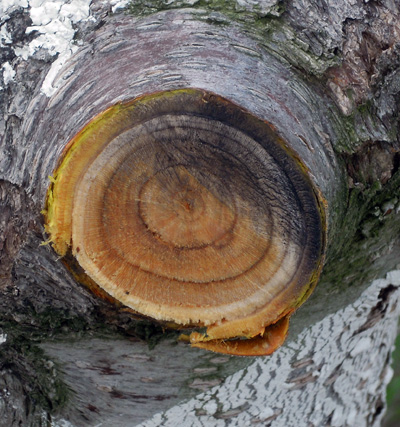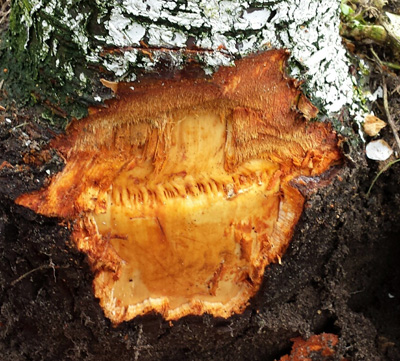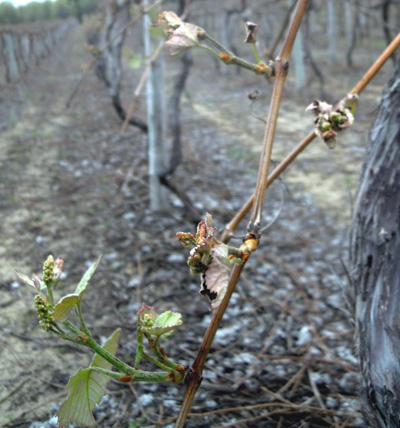Southwest Michigan fruit regional report – May 27, 2014
Plum curculio egglaying should be starting. Blueberries are full bloom across the region and winter injury becomes easier to see as affected plants show poor growth.

Weather
Temperatures last week rolled from high to low and back to high. Highs Tuesday and Wednesday, May 20-21, were in the mid-80s and dropped into the mid-60s on Thursday and Friday, May 22-23, with lows in the mid-30s on Friday and Saturday mornings, May 23-24. The passage of a cool front brought strong storms with some hail Tuesday evening and Wednesday morning. These storms were very spotty with some areas receiving almost an inch, but most areas receiving no rain at all. Average rainfall across the region last week was about a third of an inch.
Soils are drying rapidly as trees leaf out and start to use a lot of water. Careful growers have begun irrigating, especially where sandy soils are quickly drying. Soil temperatures have risen into the 60s.
Warmer weather is forecast for this week with highs in the 80s and lows in the 50s and 60s. Growers with irrigation systems are beginning to irrigate. We are about a week behind normal fruit development and a few days ahead of 2011. See the growing degree days (GDD) for the last five years in Bainbridge, Michigan, in northern Berrien County, according to Michigan State University Enviro-weather.
Southwest Michigan GDD summary from Jan. 1 through May 25, 2014
|
Station |
GDD 42 F |
GDD 45 F |
GDD 50 F |
|
Benton Harbor (SWMREC) |
610 |
484 |
321 |
|
Fennville (TNRC) |
506 |
392 |
248 |
|
Average for the region |
603 |
478 |
316 |
Winter injury symptoms
The winter of 2013-2014 was a severe winter by Michigan standards and winter injury was expected in the spring of 2014. Michigan State University Extension has posted many articles on the winter cold; see “Extent of cold injury to landscape plants from the Polar Vortex” and “Winter weather update for 2013-2014.” As spring growth becomes more developed, winter injury becomes easier to see. Winter injury is widespread in less cold hardy fruits and ornamentals, which would be damaged by winter temperatures below -10 degrees Fahrenheit. Injury is easy to see in peaches and grapes where initial growth was nonexistent or poor. Other types of injury are more localized to specific sites. In peaches, cherries, blueberries and several ornamentals, we have seen fruit buds that failed to develop or showed some initial swelling and then stopped. Other types of injury are more spotty and localized to habitually colder sites, areas and sites that had heavy crops last year and stressed the plant.
Other stresses which impact a plant’s ability to withstand winter cold include lack of irrigation and drought stress in 2013 or too much irrigation or fertilization in 2013, resulting in late growth which did not acclimate well going into winter. Initial cold temperatures in December 2013 were followed by three to four episodes of very cold temperatures across the region that dropped close to -20 F for many low sites or sites with poor air drainage (see “How cold is too cold for Michigan fruit crops?”)
We have also seen tip dieback of young shoots which were killed by winter cold. We are now starting to see the collapse of early growth in some older apples. Many examples of winter injury described in these reports are specific to one or a few sites and not necessarily the entire region. Specific symptoms for winter injury are described to allow growers to make their own assessments to their own plantings.
Tree fruit
The transition over the past week from cool to warm has stimulated fruit and leaf growth. Winter injury is becoming more and more apparent as the season progresses. Plum curculio is common and egglaying damage to young fruit is expected when nighttime temperatures reach the 60s. These conditions describe every day of the coming week and growers need to protect vulnerable fruit. The up and down temperature roller coaster has also resulted in spotty pheromone trap catches with initial catches followed by several days to a week before renewed trap catches signal a sustained flight. Several reports of brown marmorated stink bugs (BMSB) were received last week, indicating that this insect is moving out of it overwintering sites.
Apricots are out of the shuck and vulnerable to plum curculio. Apricot foliage generally looks good. Some growers in cold sites report the bloom was absent in the lower portions of some trees.
Peach fruit are out of the shuck. Crop potential is quite variable across the region. We are continuing to see tree decline in older peach orchards in areas subjected to extreme low temperatures. Cuts made in pruning young trees with no crop reveal extensive damage to the wood in the trunk. These trees will begin to show real stress when they leaf out and hot, dry weather puts a real stress on the water conducting ability of damaged wood. Leaf yellowing and wilting will be symptoms of winter injury that will become more apparent as the season progresses.

A cut through a scaffold limb on the six-year-old peach tree revels that wood older than two-years-old was damaged by winter cold. In severely damaged trees, all the wood is brown. Photo credit: Mark Longstroth, MSU Extension
Biofix for oriental fruit moth ranged from May 8 to approximately a week later. Larvae hatch was predicted to begin last week or this week, depending on whether the first or later biofix was used. Where peach scab was a problem last year, fungicides such as Bravo, Captan, sulfur or Ziram can be used to manage the disease. This disease can build up on fruit and twigs in years with incomplete brown rot programs. Some minor copper phytotoxicity symptoms can be seen on foliage in the area where growers double-applied the recommended rate for bacterial spot management. Copper application for bacterial spot management, where used for this disease, should cease by bloom, which occurred over a week ago.
In cherries, sweet cherries are over 12 millimeters in diameter with a wide range of crop loads. Foliage is relatively free of bacterial canker symptoms. Growers need to protect the crop they have. Apply cherry leaf spot controls now that the leaves are out and protect against plum curculio. Sweet cherry fruit is always susceptible to brown rot and growers are reminded that MSU Extension has found that brown rot resistance to FRAC code 11 fungicides (strobilurins) is becoming more prevalent in the area.
Tart cherries are 10 millimeters in diameter in Central Berrien County. Growers should be applying sprays to control cherry leaf spot and plum curculio. The crop looks generally good in the region. A visit to determine the cause of scattered tree death in a Van Buren County Montmorency orchard resulted in a diagnosis of collar rot (phytophthora root rot) and Prunus stem pitting caused by tomato ringspot virus. The orchard was located on sandy soil where a woodlot was cleared. No mushrooms or rhizomorphs from Armillaria root rot were noted and cuts to woody branches did not reveal streaking of the wood symptom of verticillium wilt.

The bark has been removed for the graft union of the Montmorency on mahaleb tree. Note the ring of shallow, smooth pits at the graft union, which is consistent with symptoms for this scion and rootstock combination when infected with this virus. Photo credit: Mark Longstroth, MSU Extension
Excavation of the crown and rootstock scion region revealed extensive root death consistent with Phytophthora root rot on collapsing trees. Less vigorous trees without phytophthora revealed stem pitting at the graft union of Mahaleb rootstock and the Montmorency scion. Tomato ringspot virus infects many stone fruit (see “Fruit trees in a sea of viruses”). The virus is harbored in broadleaf weeds on the orchard floor and spread by the dagger nematode. The fruiting pattern of the trees with many flower buds on last year’s shoot growth also indicated that the scions were infected with sour cherry yellows. The sour cherry yellows virus is spread by pollen from infected trees. Gibberellic acid sprays about three to four weeks after full bloom is used promote to the formation of long-lived fruiting spurs by suppressing flowering on one year old wood (see “Realize maximum yield potential in tart cherries with gibberellic acid”). The window for these sprays is opening as full bloom in tart cherries was about May 11 in Van Buren County and three to four days earlier in Berrien County.
Both Japanese and European plums have emerged from the shuck. Black knot and plum curculio are the primary concerns.
Apples range from the end of petal fall up to 8-millimeter diameter fruit. Crop load potential is generally good with some orchards light due to biennial bearing, resulting from large crops in 2013. We are entering the major window for apple thinning and growers can expect that thinners will work well excessively under these warm conditions. For a detailed discussion of apple thinning strategies, see “PGRs and Thinning Strategies” by Phil Schwallier from the 2013 Great Lakes EXPO.
Older Mutsu, Rome and Jonagold blocks are looking poor in some orchard sites, with scaffold limb dieback and brown cambium tissue. This damage is more common in trees stressed by longer-term use of contact herbicides with damage to trunks and lower scaffolds, sandy knolls, frost pockets, collar rot and mouse damage. We are attributing some of this damage to rapid drop in temperature to near zero in early December, which followed temperatures in the 50s the previous week.
Apple scab ascospore catch is declining. Ascospore release continues into early June in typical years. Apple scab symptoms from late April and early May are visible now on spur leaves. High temperatures plus rain on Wednesday, May 21, were sufficient for infection conditions for fire blight in most orchards in the Southwest region and some growers applied trauma blight sprays. The Maryblyt model predicts that symptoms from the Sunday, May 11, and Tuesday, May 13, infection episodes should begin appearing this week.
Scout for European red mites, aphids and leafroller pests such as obliquebanded leafrollers. Biofix for oriental fruit moth and codling moth was established. Spotted tentiform leafminer numbers are declining. Petal fall is the end of antibiotic application period unless a hail or high wind damages apple foliage. Apogee application to reduce risk of fire blight damage to terminals should be considered in orchards with succulent growth and susceptible varieties.
Pears are over 10 millimeter fruit in diameter. Pear scab and fire blight are ongoing concerns. Pear psylla can be found in all stages of development.
Small fruit
Fruit moved slowly with the cool weather.
Grape shoots have four to six leaves out with exposed flower. There is a wide range in shoot growth. Damage from a light freeze on Friday, May 16 became more apparent in many vineyards. Freeze caused only significant damage in some vineyards, especially those with poor air drainage so that cold air pooled and caused damage. Grape shoots are very vulnerable to temperatures just below freezing. Winter injured vines have started to show buds on cordons and trunk after a harsh winter caused extensive bud damage.

Concord grape shoots injured by a mild freeze Friday, May 16. Note the undamaged shoot in the lower left. Photo credit: Mark Longstroth, MSU Extension
We expect trunk damage in some plantings. This will become apparent as the vines leaf out normally and then wilt as the trunk struggles to provide enough water to the leaves. Some hybrid wine grapes and juice grapes in many vineyards are showing good shoot growth. Where red vinifera wine grapes are more susceptible to winter cold, it seems the red hybrid varieties are more cold-hardy.
Southwest Michigan GDD summary for grapes from April 1 to May 25, 2014
|
Station |
GDD 50 F |
|
Benton Harbor (SWMREC) |
321 |
|
230 |
|
|
Fennville (TNRC) |
326 |
|
Average for the region |
316 |
Now that shoot growth has begun, sprays to reduce phomopsis and powdery mildew should be applied during early shoot growth. Cool, wet weather is good for phomopsis infection. Grape berry moth adults were trapped this last week, however it is still too early to treat for grape berry moth. Treatment for this pest begins after bloom when egglaying begins and insecticides are sometimes included in post-bloom sprays.
Blueberry bloom progressed quickly last week. Most varieties are at or approaching full bloom. Petal fall has begun at early sites and varieties, but for most other varieties, petal fall is just beginning. With bloom across the region this week, many growers are evaluating both bloom and the growth of new leaves and shoots. Fields in some areas look pretty rough, but others show little injury. In typically cold areas, we lost leaf buds as well as flower buds to winter. Another symptom is a reduced number of flowers in the cluster. Winter injury increases to the South and to the East away from Lake Michigan. Not all inland sites are damaged, some show good growth and a good bloom.
With bloom and good pollination weather, growers need to protect against mummy berry fruit infections. Growers should scout for mummy berry shoot strikes (see “Mummy berry shoot strikes sighted in blueberries”). Bees and other insects carry the mummy berry spores from the shoot strikes to blueberry blossoms. Bloom fungicide applications are focused on preventing blossom infection by mummy berry. Fungicide applications are timed for early mid-bloom to protect the blossoms soon after they open.
Cranberry and cherry fruitworm trap catch was spotty last week, making it hard to accurately fix biofix. The approximate timing for biofix is at 350-400 GDD base 50, an accurate biofix for fields should be set by trapping adult moths. It is still a little too early to treat for these pests. The treatment window is usually at petal fall and the end of bloom (see “Time to prepare for fruitworm management in blueberries”).
Strawberry bloom continues with green fruit on the early bloom. Ripe fruit from greenhouses is being harvested. Fungicides to reduce fruit rots and foliar diseases are often applied during bloom (see “Bloom is a critical time for control of Botrytis gray mold in strawberries”).
Bramble bloom has begun in red and black raspberries. Primocane growth from the ground is vigorous.
Miscellaneous
Full bloom for several minor small fruits was noted this spring. Lornica, Honeysuckle and haskap, reached full bloom over the weekend, May 24; Aronia, choke berry, was in full bloom last Monday, May 17; and saskatoons, Amelanchier, were in full bloom a couple weeks ago, May 10.
Upcoming meetings
The next weekly Monday fruit IPM meeting is June 2 at Fruit Acres Farms, 3452 Friday Rd, Coloma, MI at 5 p.m. Two Michigan restricted use pesticide (RUP) applicator recertification credits will be given for these meetings.



 Print
Print Email
Email
